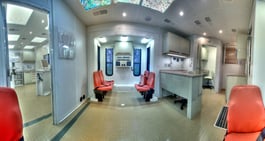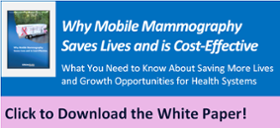In the United States breast cancer is the most common type among women after skin cancer, and is second only to lung cancer in related deaths. Thirteen percent of women nationwide will develop an invasive form of breast cancer in their  lifetime. However, breast cancer mortality rate has been declining over the past 30 years due to an increase in awareness for the need to have regular mammography screenings and the advancements in treatment. According to the American Cancer Society (ACS), women at least 40 years old should get a mammogram annually, even if they are otherwise in good health, with other sources suggesting a maximum age of 50 years old.
lifetime. However, breast cancer mortality rate has been declining over the past 30 years due to an increase in awareness for the need to have regular mammography screenings and the advancements in treatment. According to the American Cancer Society (ACS), women at least 40 years old should get a mammogram annually, even if they are otherwise in good health, with other sources suggesting a maximum age of 50 years old.
Yet women who live in rural and underserved communities have little or no reasonable access to places where they can get screenings or are even aware of the need. That’s why so many hospitals and government institutions are utilizing mobile mammography screening units to serve rural and urban African American, Caucasian, Native American and Latina women.
1) The FDA
Mobile mammography is a vital resource used by healthcare organizations around the country, and the world, to broaden access to mammography services by providing mammograms to the women where they live and work. Mobile units go onsite to tribal lands, prisons, corporations, health fairs, retail parking lots and health clinics that are not equipped to perform for mammography screenings. According to the FDA, in 2017 there were more than 300 mobile mammography units operating in the United States that are accredited under the Mammography Quality Standards Act (MQSA) guidelines. These mobile units provide full digital mammography while some also provide digital breast tomosynthesis (3D mammography).
2) American Journal of Roentgenology
In a study reported by the American Journal of Roentgenology entitled Effectiveness of a Mobile Mammography Program, patients being screened at a cancer center were considerably older (average age of 58 years) than those in a mobile unit (average age of 52 years). Much of this is associated with:
- Location; the accessibility of a mobile unit.
- Health insurance status; with more uninsured patients undergoing screenings in the mobile unit.
- Race; with more Caucasian patients being screened at the cancer center versus more African American, Hispanic, Latina and Native American patients being screened in the mobile unit.
- Marital status;
- More married patients were screened at the cancer center
- More single patients screened in the mobile unit
- More widowed patients screened at the cancer center
This study concluded that there are considerable disparities between patients having mammography screenings at the cancer center versus the mobile unit. Those visiting the cancer center are older and more likely to follow-up than those being screened using mobile mammography who had a more racial and marital diversity, higher recall rate and are less likely to follow-up. The study suggested that in identifying the disparities programs can be developed to help better increase mammography screenings and follow-up rates among underserved populations by implementing mobile mammography programs.
3) Centers for Disease Control and Prevention
The above is underscored with recent findings by the CDC. From a socio-demographic standpoint a large portion of patients who are screened at mobile mammography units are African American, Latina or other ethnic backgrounds, have incomes below $25,000, report being single and/or are uninsured. To complicate matters even more for these higher risk women, they are more likely to smoke and be obese, are less likely to adhere to other screening guidelines such as Pap tests and have not seen a primary care provider in the past year.
 The study by the CDC further suggests that mobile mammography programs effectively reach underserved women. However, those in these demographics are also inclined to not adhere to appropriate screening guidelines, where it was discovered that only 12 to 34 percent adhered to the 1-year guideline and 40 to 48 percent adhered to the 2-year guideline. This is versus the national rates of 50 percent for the 1-year guideline and 64 percent for the 2-year guideline. The objective established by Healthy People 2020 is to have 81 percent of women nationwide at least 50 to 74 years of age screened for breast cancer.
The study by the CDC further suggests that mobile mammography programs effectively reach underserved women. However, those in these demographics are also inclined to not adhere to appropriate screening guidelines, where it was discovered that only 12 to 34 percent adhered to the 1-year guideline and 40 to 48 percent adhered to the 2-year guideline. This is versus the national rates of 50 percent for the 1-year guideline and 64 percent for the 2-year guideline. The objective established by Healthy People 2020 is to have 81 percent of women nationwide at least 50 to 74 years of age screened for breast cancer.
The Healthy People program was established by the Office of Disease Prevention and Health Promotion (ODPHP) and has a 10 year national objective to improve the health of all Americans. For the past 30 years Healthy People has established benchmarks and monitored progress to:
- Encourage collaborations across communities and sectors
- Empower individuals toward making informed health decisions
- Measure the impact of prevention activities
The CDC study identified disparities in breast cancer screenings with underserved women and emphasized the significance of using mobile mammography as a primary community outreach strategy to improve access to mammography screenings and adherence to necessary guidelines. Having hospitals and government institutions (i.e. the Indian Health Service, the Office of Diversity and Inclusion within the VA and the U.S. Office of Minority Health) incorporate mobile mammography is going to be a key element in reaching the Healthy People 2020 goal of having 81 percent of women in the targeted age group screened and ultimately treated for breast cancer.
This study also confirmed what others found; that women who underestimate their risk of having breast cancer tend to be from any combination of racial and ethnic minorities, less educated or below the poverty line. Mobile mammography should be a primary component in plans to resolve disparities in screening rates. Efforts to increase mammographic screenings among underserved women could be enhanced by reaching them with mobile mammography programs and providing education on the risks of breast cancer. Education is the first line of defense that should be addressed in research and public policy.
As hospitals and institutions work to implement mobile programs they must ensure their services are provided in a manner that is sensitive to the cultural differences of the racial and ethnic populations they serve.
Download our white paper on how Mobile Mammography can benefit your institution and those you serve:
Additional Sources Include:


